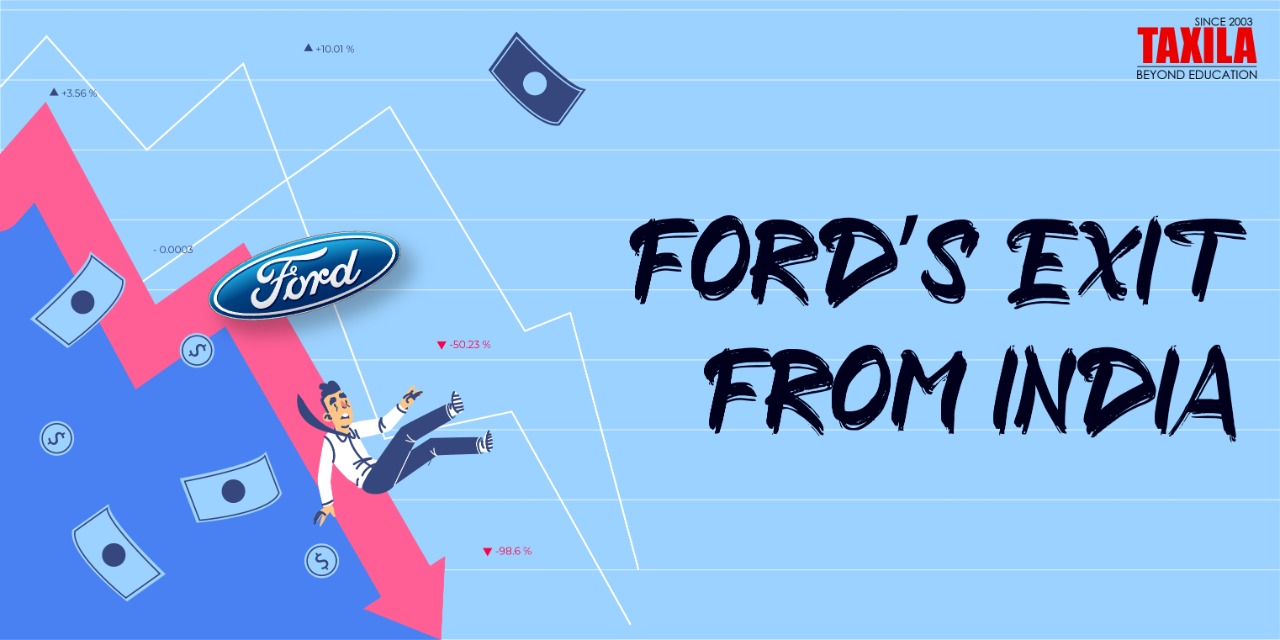
Ford's decision to stop producing cars in India makes us reflect on the company's tumultuous history to discover why it misread the Indian market so badly. Surprisingly, the American automaker followed the rules to the letter. It established entire manufacturing activities in India, including two vehicle production plants with a capacity of 440,000 units per year, a state-of-the-art engine facility, and a broad supplier base to ensure that its models have a high level of local content. Ford focused on the bulk, sub-4-metre category for economies of scale, and it even made India a significant export base for higher volumes to make its expenditures (about US $ 2 billion over 25 years) pay off.
Ford products were well-engineered, set a standard for driving dynamics, reasonably priced to buy and latterly had become cheap to operate as well. And, unlike many multinationals, Ford invested in BS6 diesel technology in the idea that India will continue to be a significant diesel car market. So, what went wrong for Ford? It was evident that it wasn't due to a lack of devotion. In truth, the American automaker adopted the very same business model in India as some of its most successful competitors, such as Hyundai, but it failed to break the Indian code after 27 years of losses. This is because this code isn't contained in any rule book, strategy paper, or the PowerPoint presentations that consultants charge millions for.
To succeed in the very complex Market of India, one must make his own unique rules, stay street smart, maintain your ear to the ground, and be quick and agile enough to adjust to changing customer preferences in a fast-changing market. It wasn't just bad planning that got Ford, but also some fundamental blunders in judgment or simply not 'understanding India. ‘Here are five reasons why Ford's recovery was never complete:
- Undervaluing the Indian buyer and his purchasing power
Following the de-licensing of the auto industry in the mid-1990s, multinational corporations scrambled to get a foothold in what was then considered the world's last untouched market. Ford was one of the first multinational corporations to enter India, but it misjudged the Indian consumer. After decades of being denied access to new items, it was assumed that Indians would eagerly accept everything a worldwide company gave.
The collapse of Ford's first model, the Escort, served as a wake-up call. The Escort had an ancient 1.3 petrol engine, no power steering (though the diesel did), and no rear passenger power windows. It was rejected by Consumers in India.
The reality of the Market in India hit Ford strongly, and the company realized it couldn't simply parachute one of its worldwide vehicles into the country; it needed to create something specifically for the Indian market. Ford's first made-in-India car, the Ikon, was born as a result of these experiences and became an immediate hit. The Ikon, the very first version to leave Ford's Maraimalainagar facility in Chennai, had a reasonable amount of local material, allowing it to be reasonably priced. It was functional, had enough room for its category, and drove like a dream. It's no wonder that it was the finest car in the midsize market in its first full year of sales.
After several years, though, the hefty price of the product started to bite. For example, Darius Lam, a former Autocar Professional staffer, was charged Rs. 70,000 to fix the air conditioning unit in his five-year-old Ikon, which had a resale value of less than Rs 150,000! Maintenance shock was widespread, and it earned Ford a perception of high cost of ownership, which hurt sales and, in turn, hurt resale value, causing major damage to the brand. Fords had a corporate image for being high-maintenance vehicles.
Ford didn't give up, but it did take these hard warnings seriously. Ford had found out what Indian customers wanted with the Figo. Besides from being an economical, low-cost-of-ownership, and functional car (which the Figo was), it also had to be low-cost-of-maintenance. Customers despised the eye-watering repair bills. The concept of creating more "child parts" and localising the Figo paid out.
The 2011 Autocar Car of the Year, the Ford Figo, was a pivotal event for Ford, establishing its entry-level hatchback as a more capacious and sturdy option to the smaller and lighter econoboxes. In FY2011, the Figo sold 78,116 units at its peak. However, the brand's reputation as a costly automobile to own clung to it like a terrible odour. Ford took more than a decade to address the issue of cost of ownership by offering lower-cost supplies and servicing and spending millions of dollars on marketing to dispel the myth. That was too late by then.
- Investing excessively in an overvalued market
Ford authorised a plan in 2011 to invest $1 billion (Rs 7,401 crore) in a second, state-of-the-art factory in Sanand, Gujarat, with a capacity of 240,000 units per year, buoyed by the success of the Figo, which reached a peak of 78,116 units in FY2011 and a market predicted to rise to 7 million cars. The huge success of the EcoSport, which was launched in 2013, boosted optimism in the Indian market even further. The rapid expansion of the Indian market had slowed after the inauguration of the Sanand facility on March 26, 2015, by then-global CEO Mark Fields.
Exports had also failed to take off in the way Ford had hoped, implying that capacity utilisation was significantly below break-even. This facility became a millstone around Ford's neck due to Ford's misjudgement of the Indian market's growth potential and, more crucially, Ford's own growth potential. Sanand caused Ford to haemorrhage due to its limited capacity, and the business never recovered from the massive losses. Indeed, it's plausible that Ford would not have had to close its India operations if it hadn't decided to invest in Sanand.
- Focusing on Maruti Suzuki rather than the SUV market
Ford began pursuing quantities with the opening of the Sanand facility, moving deeper into widespread niches with sub-4-metre vehicles like the Figo and Aspire. As a result, Ford decided to compete directly with Maruti Suzuki and Hyundai with tiny sedan and hatchback models, which was a huge error. While Ford did a great job of cutting the operating expenses of all of its vehicles to fight in the budget segment, it landed up with a broken nose and learned the hard way that the leaders lock out the bottom of the pyramid.
For the past 35 years, every vehicle manufacturer has attempted to compete with Maruti and failed because they haven't figured out the equation. And that equation is a mix of low-cost, high-fuel-efficiency, and completely dependable vehicles distributed in a well distribution system that touches every corner of the country.
Ford skipped out on the SUV bandwagon, which is the largest rising and also most lucrative segment of the market, by focusing on its "B-cars" (Aspire and Figo). The success of the Ecosport should have been a warning sign, but Ford overlooked the space between the Ecosport and the Endeavour, which proved to be the most profitable part of the market, which the Koreans have completely seized.
Ford considered launching the Kuga midsize SUV as a Creta competitor in 2015, but due to a lack of localization, expenses could not be dragged down to a competitive market, and the concept was abandoned. Ford re-evaluated the midsize SUV category, and the B772, a Creta rival built on an all-new architecture shared with Mahindra, had reached an advanced level of development. But, once again, the partnership fell apart, and the idea failed.
- Investing where it isn't important but not investing where it is.
Not only Ford, but nearly every other international manufacturer is unable to get the pricing structure appropriate for India, leaving them unsustainable in the market. Understanding where to invest and where not to invest is a delicate balancing act that only Maruti Suzuki has achieved.
Ford was a perfect illustration of overspending where it didn't benefit consumers and cutting costs where it did. The Sanand facility, for example, was built like a "Taj Mahal" to expensive international criteria, some of which were irrelevant to India. Why squander money on a structure designed to withstand a gale force rating of 9 simply because Ford's factories in America (which is hit four times more by storms than any other country on the planet) are? Why spend 6-7 times as much on forklifts (which a company needs) as Mahindra or Tata would only to fulfill Ford's global standards? This mindset, of mindlessly following an expensive international benchmark, no matter how useless it may be, is what drives up expenses.
Employee expenditures are also exorbitant (rumoured to be Rs 10 lakh per annum on average for each employee), which has a negative impact on the bottom line. It's little wonder, then, that the break-even volume to justify the Sanand plant's construction was 100,000 units per year, a target Ford never approached. Ford didn't prefer to spend where it should have, on its automobiles, which is one of the reasons it never came close to hitting these volumes. Again, the corporation did not skimp on safety and construction quality, which didn't even matter to the client as much as budget in terms of materials, equipment, and features did. While Korean businesses treated customers with new gadgets, Ford began removing amenities (such as the fantastic Sync 3 infotainment system) from its cars to save money, which did not sit well with buyers.
Furthermore, Ford did not devote sufficient marketing resources to its capable goods, particularly when they were first introduced. The promotional campaign triggered by the Maruti S-Cross and Hyundai Creta debuted around the same time drowned out the launch of the Aspire, a significant mass-market vehicle in 2015. The Aspire and Figo simply did not generate the same level of excitement as the spectacular Ecosport.
- Strong Culture for its own good
In the auto sector, Ford's reputation as an employer is perhaps unrivalled. The global carmaker Ford, which is controlled by the Ford family, has a strong family values and ethics culture. Yet, this "Strong culture"attitude was beneficial to employees and their partners, it weakened the competitiveness required to succeed in a tough market like India.
Ford's easygoing demeanour and lack of hostility were evident from the start, while the business was constructing the Maraimalainagar factory. Hyundai was building its first factory not far away in Sriperumbudur at the same time, but it finished a year before For. While Ford officials went golfing on weekends, the Koreans worked nonstop to finish the factory in record time. This exemplified Ford's laid-back attitude, which allowed ambitious competitors to surge ahead.
Ford's leniency for non-performing dealers has also proved to be its downfall. Instead of smacking the hammer on errant dealers, some of whom are suspected of diverting profits into the real estate business rather than ploughing them back into the dealerships, were not dealt harshly enough because they were 'family members.' It's now up to Ford to decide what kind of payout it would offer defunct dealers after the company shuts down.
Ford made few mistakes in the Indian market such as majorly its perception of high cost of ownership, the company had to close its India operations because of its wrong investment decision in Sanand, overspending where it didn't benefit consumers and cutting costs where it did. Of course if these shortcomings were dealt on time and with efficiency it could have let the company survive longer in the Indian market. But yes, this case comes with lifelong lessons to other companies in the Indian market.

Prof. Lavina Khilnani
MBA
A highly dedicated and result-oriented professional with excellent communication skills. Proficient in using an enthusiastic and dynamic teaching technique as a means of creating better learners.

